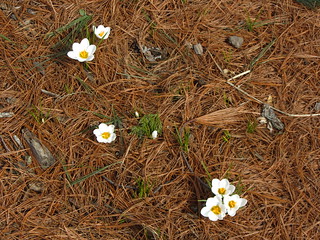
I'm a writer, publishing both as SJ Rozan and, with Carlos Dews, as Sam Cabot. (I'm Sam, he's Cabot.) Here you can find links to my almost-daily blog posts, including the Saturday haiku I've been doing for years. BUT the blog itself has moved to my website. If you go on over there you can subscribe and you'll never miss a post. (Miss a post! A scary thought!) Also, I'll be teaching a writing workshop in Italy this summer -- come join us!
Read/Post Comments (0)

Famous Pickles and Very Important Moss
At the Matsumoto train station you can buy pickled vegetables to take home as souvenirs. They're available for tasting from little covered glass dishes. Some are sweet, some are spicy, all are of a less crunchy texture and come in many more colors (soft and lovely) than American pickles. Matsumoto, Seiichiro informs me, is "famous about pickles." This would be more impressive if we hadn't seen similar displays in the train stations in Kyoto, Kanazawa, Nagoya, and even Tokyo. Seems that every region of Japan considers itself famous about pickles. The assortment of vegetables they use varies, as do the spices, but basically they're similar, at least on the western palate, though apparently there's quite a competition among them. Still, for a waiting-for-the-train snack, you could do worse than circle the pickle-tasting stand in Matusmoto.
Kyoto -- some of these reports are out of order, it's true, as things come to me or I come to an Internet cafe -- has a few hundred temples and shrines, so on one trip you only see a tiny number of them. One of the most beautiful is the one known colloquially as the Miserable Women's Temple, because of its first inhabitants: girlfriends, as our guide had put it the day before, whom the Shogun had thrown away. Few westerners bother to try to find this place, but I'd seen a picture of it and I was interested, so we found a cab driver who hauled us up there and waited while we strolled around. It's a tiny two-room wooden building on a steep hillside. It sits in a bamboo grove, and all around the ground and the rocks are covered with moss. It's silent and though it has little land, it's surrounded by forest and the overall impression is green, still and quiet. I think I might not be so miserable if I lived there.
A small display of pots shows each different kind of moss, labeled in Japanese. At the Silver Pavilion, a much bigger temple in town and very much on the tourist itinerary, there's a similar display, with the pots divided into 3 English-labeled groups: "Invader Moss," "Everyday Moss," and "Very Important Moss (Like VIP)." Luckily for the moss, the VIP group is the largest. We wondered how they kept the very important moss clean, especially when the leaves start to fall. After all, you can't rake it, it's too delicate. Then we saw a woman with a small whisk broom made of just a few thin twigs, crouching on the moss (she was wearing white socks and no shoes) and patiently brushing leaves off it onto a little flat pan. Pays to be a VIP.
Kyoto -- some of these reports are out of order, it's true, as things come to me or I come to an Internet cafe -- has a few hundred temples and shrines, so on one trip you only see a tiny number of them. One of the most beautiful is the one known colloquially as the Miserable Women's Temple, because of its first inhabitants: girlfriends, as our guide had put it the day before, whom the Shogun had thrown away. Few westerners bother to try to find this place, but I'd seen a picture of it and I was interested, so we found a cab driver who hauled us up there and waited while we strolled around. It's a tiny two-room wooden building on a steep hillside. It sits in a bamboo grove, and all around the ground and the rocks are covered with moss. It's silent and though it has little land, it's surrounded by forest and the overall impression is green, still and quiet. I think I might not be so miserable if I lived there.
A small display of pots shows each different kind of moss, labeled in Japanese. At the Silver Pavilion, a much bigger temple in town and very much on the tourist itinerary, there's a similar display, with the pots divided into 3 English-labeled groups: "Invader Moss," "Everyday Moss," and "Very Important Moss (Like VIP)." Luckily for the moss, the VIP group is the largest. We wondered how they kept the very important moss clean, especially when the leaves start to fall. After all, you can't rake it, it's too delicate. Then we saw a woman with a small whisk broom made of just a few thin twigs, crouching on the moss (she was wearing white socks and no shoes) and patiently brushing leaves off it onto a little flat pan. Pays to be a VIP.
Read/Post Comments (0)
Previous Entry :: Next Entry
Back to Top